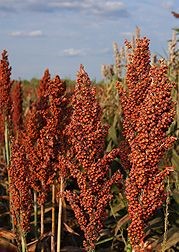WASHINGTON, May 31, 2017 - The economics of sorghum production aren’t nearly as dismal as some aggregate data may suggest.
 In fact, Jennifer Blackburn, external affairs director for the National Sorghum Producers (NSP), points out that grain sorghum prices at Louisiana and Texas port terminals have recently leapt to more than $4.60 a bushel, besting corn by more than 50 cents at those ports. Grain sorghum, which competes with the much larger U.S. corn crop, almost always sells for less than corn, and does now in most places. But, “farmers in that area can and will deliver straight to the port to take advantage” of the current premium prices there, she said.
In fact, Jennifer Blackburn, external affairs director for the National Sorghum Producers (NSP), points out that grain sorghum prices at Louisiana and Texas port terminals have recently leapt to more than $4.60 a bushel, besting corn by more than 50 cents at those ports. Grain sorghum, which competes with the much larger U.S. corn crop, almost always sells for less than corn, and does now in most places. But, “farmers in that area can and will deliver straight to the port to take advantage” of the current premium prices there, she said.
The port prices are the kind of treatment sorghum growers have been striving for since creating the United Sorghum Checkoff Program nine years ago to pay for crop research, product development and market expansion for grain sorghum, also called milo, and other sorghum crops.
In recent years, however, all grains have been swamped in the same production glut. Corn makes up nearly 95 percent of the U.S. feed grains supply (sorghum, 3 percent), and it “is just overwhelming,” says Tom Capehart, senior economist for the USDA Economic Research Service. “We’re in just an incredible global glut, and it’s very hard for sorghum to compete with the very cheap corn,” he said.
So, sorghum prices, in the range of $5-$6 a bushel when corn prices were high, will average just $2.60 to $2.80 to farmers this marketing year, USDA projects. While soft prices have dimmed incentives for planting, invasions of sugar cane aphids in the past two years in the crop’s prime region – the southern and central Great Plains – have slashed yields and raised production costs, thus piling on more disincentives to sorghum. It was no surprise that, in March, U.S. farmers told USDA they expected to seed less than 5.8 million acres of sorghum, a third less than the nearly 8.5 million just two years ago.

NSP CEO Tim Lust
Total planted acreage is hard to predict, Lust said, because so much acreage is planted late -- often by replanting failed acres of cotton or corn. “It’s safe to say, it’s not going to be 8 and a half million acres,” he said. But, on the other hand, the acceleration of crop improvement research is paying off, and farmers are getting bigger yields. “We’ve broken national yield records in the past two years,” he notes. The 2016 average was 77.9 bushels per acre, and the average U.S. yield of the past three seasons – 73.8 bushels – is up 36 percent from the previous three years.
“I think the really exciting part of our industry is the demand story,” Lust declares. “We are basically selling the entire sorghum crop every year.”
For sorghum, demand starts in foreign markets. The primary uses for the country’s grain sorghum are the same as corn: animal feed, exports, and ethanol plants. But the proportions are far different. Exports typically account for about 15 percent of corn use, while the export share for sorghum is trending upward, and foreign sales have claimed more than 75 percent of sorghum in some recent years. USDA projects about 60 percent of the 2017 harvest will be sold abroad. Meanwhile, about a third of both corn and sorghum become ethanol and distillers’ grains. Grain sorghum used as wild bird seed remains quite steady at just 1 percent of domestic use.
But Lust says the share of sorghum used for animal feed is slipping overall while that going into food products, including pet foods, is rising. “Food has not been a key component of the U.S. sorghum market. Twenty years ago, we had one professor at Texas A&M (University), Dr. Lloyd Rooney, who was basically the entire sorghum food industry in the United States,” Lust said. But now, he said, countless researchers in private and university food labs work on sorghum food products. “We’ve come a long way in a few short years,” he said.
The type of new sorghum products is changing as well: “Back in 2013-2014, almost all of our new food launches were tied to gluten free or tied to non-GMO,” Lust said. But that share is way down, “and we are moving now into more mainstream products.” For example, “Papa John’s started into five regional markets with an ancient grain pizza crust made out of sorghum,” he said.
Lust says NSP has been delighted to see recent attention by food publications, such as the James Beard Foundation’s 2017 food trends designation of sorghum as a “food trend crop of the year.” That’s unusual for a bulk commodity, he said.
China recently suspended orders for U.S. sorghum, perhaps to reduce excess stocks, Capehart suggests. But consumption there of baijiu, a distilled sorghum liquor, and feeding of grain sorghum to ducks, will continue to increase. China, which usually accounts for three-fourths of U.S. sorghum exports, will probably be buying American again soon, Lust and Capehart say.
#30


